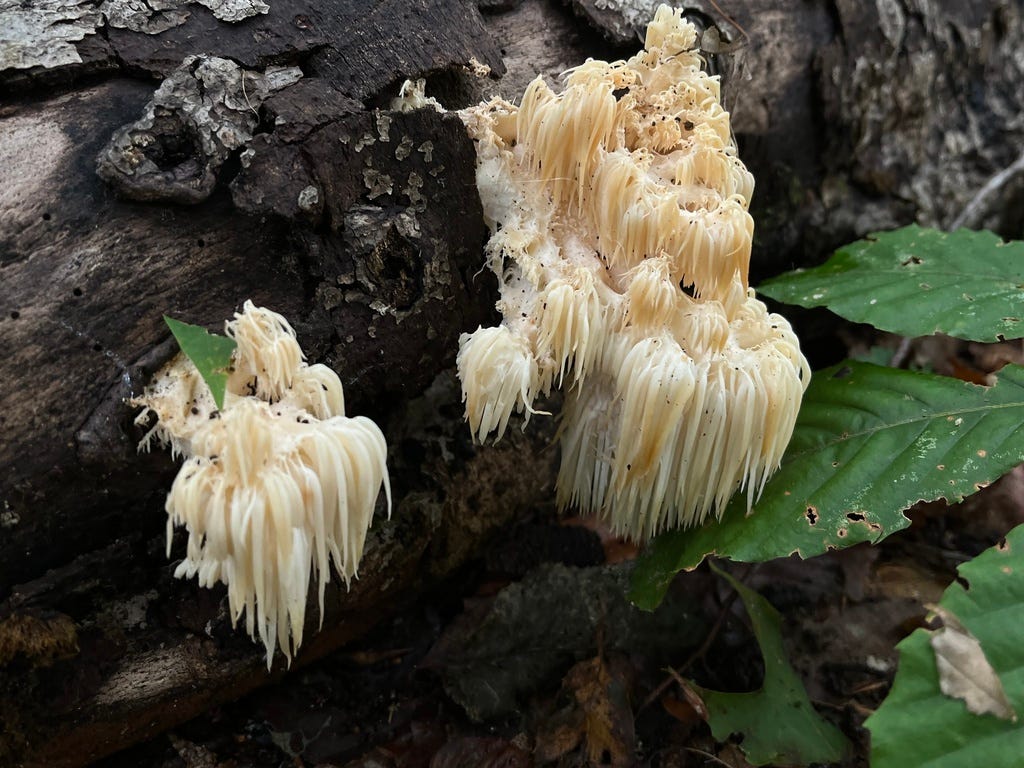Good evening, friends,
This week’s mushroom is the Bear’s Head Tooth (Hericium americanum) which was all over the Adirondacks when I was up there two weeks ago. It’s been dry though recently, huh? The only mushrooms I really see out right now are tremendous flushes of honey mushrooms (Armillaria mellea) and chicken of the woods (Laetiporus sulphureus). There are some Russulas still kicking around, too.
I was thinking that during the dry conditions honey mushrooms (Armillaria mellea) - a pathogen on tree roots - have greater flushes as the trees struggle with the lack of water. Or perhaps they are able to get water from the tree roots they are digesting. Or they’re just prolific mushroom producers and resistant to the drought. Anyway, rain would be great and in the meantime let’s learn about this native Hericium.

Fun Facts
Hericium species are highly sought-after not just for their choice edibility, but also their promising medicinal properties. The most researched species is Hericium erinaceus and that’s the species used in supplements/extracts. However, it’s likely a lot of those beneficial, nootropic (cognitive enhancing) compounds can also be found in H. americanum as well - the research just isn’t there yet. Hericenones are one of these desired compounds as they promote the production of nerve growth factor which aids brain cell health and longevity.

One of the few studies conducted solely on H. americanum found the mushroom displayed both antifungal and antibacterial properties in a lab setting (in vitro) (Reference 3). Another interesting note is that these compounds are concentrated in different parts of the fungus ranging from the fruiting body to the mycelium. There’s controversy in the supplement/extract business about whether the mycelium or the fruiting body has more medicinal potency, and I guess in this instance it depends on which compounds you want.
A different study found that H. americanum had the highest concentration of ergothioneine (a type of amino acid with antioxidant & anti-inflammatory properties) out of the three Hericium species they examined (Reference 4).

Ecology
The fungus is saprobic and prefers soft hardwoods like beech and maple, but can also digest tulips and sweetgums of which we have many in the NYC area. However, this is an uncommon species at this latitude and I see Hericium erinaceus more often down here.
When I was in Ecuador, there was a guy on the trip who studied Hericium as an undergrad at Evergreen State College and he told me that H. erinaceus is not native to North America. You won’t find that info anywhere online, the websites all say it’s a North American mushroom, but that “sounded right” to me at the time. As I look at iNaturalist observations now, it’s pretty well established in the continent to have been introduced, but perhaps it was brought over to be cultivated and escaped cultivation.
H. americanum is endemic to (only found in) North America east of the Rockies while a nearly identical species, H. abietis, grows on conifers west of the Rockies. There are two other Hericium species you’ll see in the northeast (pictured below) that you’ll find in the northeast - H. erinaceus and H. coralloides. All three of these Hericium fruit in the fall as the temperatures cool and fortunately we can pretty confidently identify them based on physical characteristics alone.
Tellin ‘Em Apart
Lion’s Mane (Hericium erinaceus)

Bear’s Head Tooth (Hericium americanum)

Coral Tooth (Hericium coralloides)

This upcoming weekend we’ve got a foraging-focused Friends of Fungi retreat up at the Menla Resort & Spa in Phoenicia, NY. Still time to join :)
Full moon tonight (as in right now on Tuesday, if you’re reading this on Wednesday you can still see a pretty full moon tonight),
Aubrey
Bonus Red Eft negotiating their way through puffballs
References:
Kuo, M. (2022, July). Hericium americanum. Retrieved from the MushroomExpert.Com Web site: http://www.mushroomexpert.com/hericium_americanum.html
Song X, Gaascht F, Schmidt-Dannert C, Salomon CE. Discovery of Antifungal and Biofilm Preventative Compounds from Mycelial Cultures of a Unique North American Hericium sp. Fungus. Molecules. 2020 Feb 20;25(4):963. doi: 10.3390/molecules25040963. PMID: 32093422; PMCID: PMC7070493.
Kostanda E, Musa S, Pereman I. Unveiling the Chemical Composition and Biofunctionality of Hericium spp. Fungi: A Comprehensive Overview. Int J Mol Sci. 2024 May 29;25(11):5949. doi: 10.3390/ijms25115949. PMID: 38892137; PMCID: PMC11172836.







It's Wednesday morning as I read, but my kids and I enjoyed watching the clouds rush past the bright full moon. It looked as if the moon was racing through the sky. Far from exciting the children, it calmed them toward sleep and made for a really easy goodnight. Result!
As always, brilliant photos, thank you for sharing.